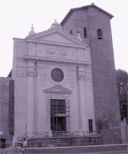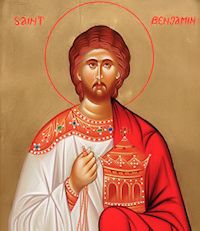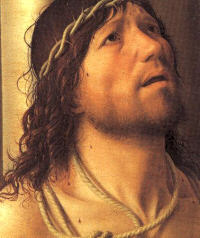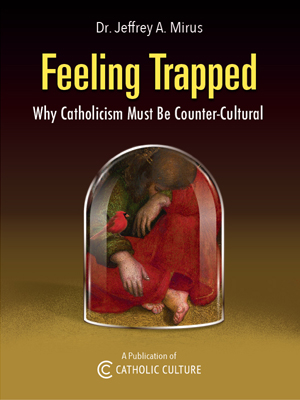Lent: March 31st
Monday of the Fourth Week of Lent
Other Commemorations: St. Benjamin, Deacon and Martyr (RM)
» Enjoy our Liturgical Seasons series of e-books!
During the next two weeks the Gospel for each Lenten weekday Mass is from St. John. We shall read, day after day, about the growing hostility against Jesus that climaxed in the horror of Good Friday. The tragedy begins today on a happy note—a continuation of yesterday’s Laetare Sunday spirit. —The Vatican II Weekday Missal
The Roman Martyrology commemorates St. Benjamin (d. 424), a martyr of Persia (modern Iran) and a deacon in the persecution conducted by the Sassanid rulers Yazdigerd I and his son Varahran. He was tortured and impaled.
Meditation for Monday of the Fourth Week of Lent
In the first reading of today's Mass, the prophet Isaiah offers a vision of the Messianic Age, which Jesus proclaimed to have begun in himself and by his ministry. The Easter "surprise" toward which the Forty Days leads pilgrims is that this Messianic Age, the Kingdom or Reign of God, will break into history in a wholly unexpected, even counterintuitive, way: it will be established through a new Passover marked by the Cross, the Resurrection, the Ascension, and the sending of the Holy Spirit at Pentecost. And as a result, a new People of God that embraces both Jews and Gentiles will be born into history. For now, Jesus gives another sign of the inbreaking of the Kingdom in today's gospel reading, the cure of the royal official's son. The official, like all disciples, must abandon himself to the divine will: As Father Benedict Bro, a Dominican, put it, "God is God only when I accept the fact that I need him."
Another Dominican, Bede Jarrett, developed the same theme in a way that sheds more light on the imitation of Christ, the obedient Son, to which this phase of the Forty Days calls us:
This life of ours…is a gift from God. It is not of our choosing. It comes to us by his choice. Since it is of his choosing, it is of his designing. We neither made ourselves nor can we manage ourselves as we like, nor manage the life that comes to us. For that reason we can take a most helpful view of life….[For] the thought that it is his gift and after his design gives us courage. If to this remembrance of God's creatorship we add the mystery of the Resurrection, we shall take even larger draughts of hope; for not only life but life's triumph lies entirely in the hands of God
—George Weigel, Roman Pilgrimage

Monday of the Fourth Week of Lent
Station with Santi Quattro Coronati (the Four Crowned Saints):
Approaching the medieval gateway of this ancient church, dedicated to the Four Crowned Saints, one immediately gathers that this is a unique place. Indeed it is, for though it stands only a few blocks from some of the busiest areas of the city, this oft-forgotten church holds centuries of tradition within its scarred walls. The title of this church is actually in reference to two groups of martyrs from the Roman persecutions. The first group were four soldiers, Severus, Victorinus, Carpophorus, and Severinus, who refused to take part in pagan worship, and were killed for this in the persecutions of Diocletian. The name of this church may be derived from a military decoration of a small crown, which the four soldier saints may have earned during their service. The second group were a group of five stonemasons, Claudius, Nicostratus, Sempronianus, Castor, and Simplicius, who were put to death for their refusal to carve a statue of Asclepius which would be used for pagan worship. (See PNAC for more details.)
For more on Santi Quattro Coronati, see:
For further information on the Station Churches, see The Stational Church.
St. Benjamin
 The Christians in Persia had enjoyed twelve years of peace during the reign of Isdegerd, son of Sapor III, when in 420 it was disturbed by the indiscreet zeal of Abdas, a Christian Bishop who burned the Temple of Fire, the great sanctuary of the Persians. King Isdegerd threatened to destroy all the churches of the Christians unless the Bishop would rebuild it.
The Christians in Persia had enjoyed twelve years of peace during the reign of Isdegerd, son of Sapor III, when in 420 it was disturbed by the indiscreet zeal of Abdas, a Christian Bishop who burned the Temple of Fire, the great sanctuary of the Persians. King Isdegerd threatened to destroy all the churches of the Christians unless the Bishop would rebuild it.
As Abdas refused to comply, the threat was executed: the churches were demolished, Abdas himself was put to death, and a general persecution began which lasted forty years. Isdegerd died in 421, but his son and successor, Varanes, carried on the persecution with great fury. The Christians were submitted to the most cruel tortures.
Among those who suffered was St. Benjamin, a Deacon, who had been imprisoned a year for his Faith. At the end of this period, an ambassador of the Emperor of Constantinople obtained his release on condition that he would never speak to any of the courtiers about religion.
St. Benjamin, however, declared it was his duty to preach Christ and that he could not be silent. Although he had been liberated on the agreement made with the ambassador and the Persian authorities, he would not acquiesce in it, and neglected no opportunity of preaching. He was again apprehended and brought before the king. The tyrant ordered that reeds should be thrust in between his nails and his flesh and into all the tenderest parts of his body and then withdrawn. After this torture had been repeated several times, a knotted stake was inserted into his bowels to rend and tear him. The martyr expired in the most terrible agony about the year 424.
—Excerpted from Saints and Angels
Highlights and Things to Do:
- Read more about St. Benjamin:
- If you are named after St. Benjamin you can find a medal of him at the Catholic Company.
- St. Benjamin is also honored in the Eastern Orthodox Church and the Byzantine Rite Eastern Catholic Churches on October 13.






